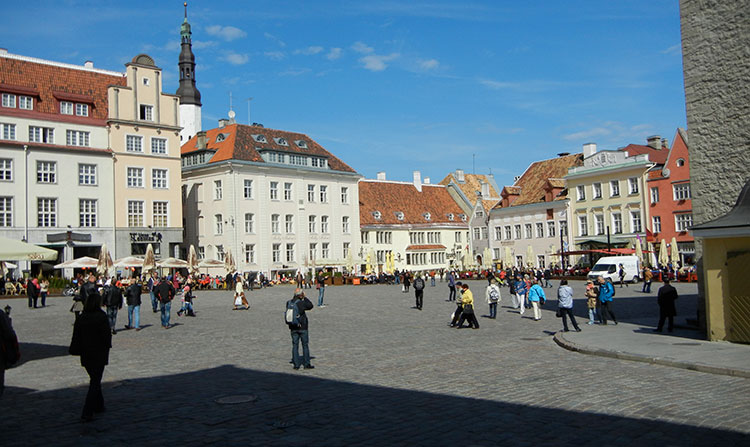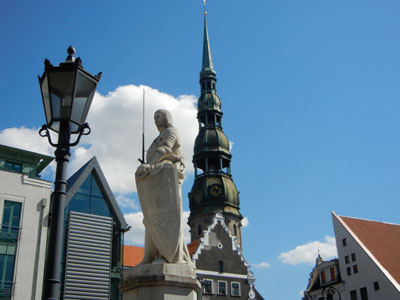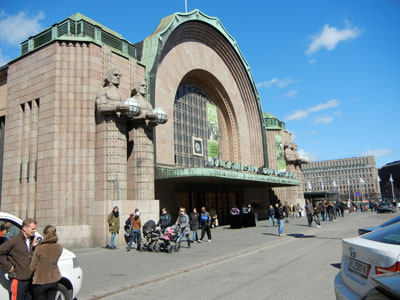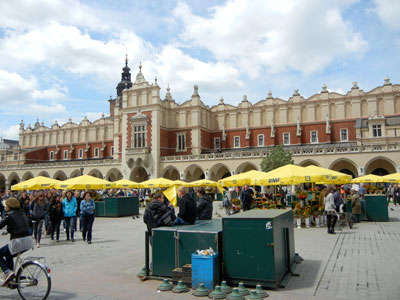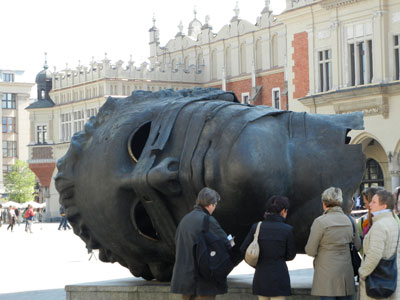An independent exploration of the Baltic countries of Latvia, Lithuania and Estonia plus time for Poland
This article appears on page 32 of the June 2013 issue.
by Richard Berner; San Diego, CA
My wife, Martha, and I had wanted to travel to the Baltic states of Estonia, Latvia and Lithuania since a trip to Russia in 2005 piqued our interest.
We started our 2012 trip in Helsinki, Finland — an easy ferry ride from Tallinn, the first of the Baltic capitals we would visit.
Helsinki
Leaving home on May 1, we flew from San Diego to Helsinki via New York City on American Airlines and Finnair. The flight on the new, sparkling Finnair Airbus 330 was much nicer than the American Airlines flight. The individual TV screens were especially welcome to help pass the time on a transatlantic flight.
From the Helsinki-Vantaa Airport, we took a public bus (€4) to Hotel Finn (3B Kalevankatu) for a 2-night stay. It was a modest but comfortable hotel and a good value (€99, or $129, per night ) for this expensive city.
We toured Helsinki on foot, using their convenient tram system. Both the Rick Steves guidebook and the local tourist information office had instructions for a self-guided hop-on/hop-off public tram tour (day pass, €7).
The highlights of the tour, for us, were the Art Nouveau Central Station, the Temppeliaukio Church (aka Church of the Rock) and the National Museum of Finland. We also took an orientation walk outlined in our guidebook.
Three notable places in which we ate are Putte’s Bar & Pizza (Kalevankatu 6), where we had pizza and wine for €20 (try the “Silence of the Lambs” pizza); Café Esplanad (Pohjoisesplanadi 37), where our lunch cost €15, and a fine, old-fashioned place, Café Ekberg (9 Bulevardi), where we enjoyed lunch for €20.
On to Estonia
After two days in Helsinki, we purchased two tickets (€63) from Linda Line for the 90-minute express ferry across the Gulf of Finland to Tallinn, the capital of Estonia. Upon arrival, we took a taxi from the company recommended by Geli, our apartment agent.
Our large one-bedroom apartment at 22 Sakala (phone +372 56 217 114) exceeded our expectations. It was well furnished, very roomy and clean, all for €70 per night.
Near our apartment was the Reval Café (Sakala and Pärnu mnt), our morning stop for coffee. We also had an inexpensive dinner (€20) there one evening. In the Solaris Center, two blocks away, there was a supermarket where we purchased groceries.
After unpacking, we walked a few minutes to Tallinn’s Old Town. This beautiful city has retained much of its medieval flavor.
After a stop at the tourist information office, we started a walking tour from our guidebook, focusing on the lower town and its main street, Pikk Street. We saw some of the former city walls from the 14th century and many buildings also dating back hundreds of years.
Stopping on the picturesque Town Hall Square (Raekoja plats) for a glass of wine (€3) at the Wine Library, we were pleased to see prices more reasonable than those in Helsinki.
We later had an excellent dinner (€44 for two) at Must Llama (Sauna 2), which specializes in Russian food from Georgia, Armenia and Azerbaijan. About 40% of Tallinn’s population is Russian, having immigrated to Estonia during the Soviet occupation.
Exploring Tallinn
On later days, we completed our walking tour of the city, including the Upper Town (aka Toompea). We were there on a Sunday, and the entire congregation of the Russian Orthodox church came out and followed the priest through the streets in all their robes and finery.
One of our favorite sites was the striking Kumu Museum, designed by Finnish architect Pekka Vapaavuori. To reach it, we took a tram (free for seniors) two kilometers east of Tallinn’s center to Kadriorg park, then walked through the park to the museum.
Kadriorg park was built in the 18th century by Peter the Great for Empress Catherine. Within its grounds are the residence of the President of Estonia and formal gardens.
To see more of the surrounding area, we took a local bus along the coast to Pirita, an area five kilometers east of Tallinn known for its marina and beaches.
After three days in Tallinn, we took a tram to the bus station and purchased tickets to Riga, Latvia, for €14 each. It was a comfortable 5-hour bus ride through the countryside.
Riga
Upon arriving in Riga, the Baltics’ largest city, we walked to our hotel after an ATM stop for some Latvian lats. Our hotel, Radi un Draugi (Marstalu iela 1), was very comfortable and well located in Old Town. Our room cost LVL52 ($97).
Walking through the area after settling in, we passed St. Peter’s Church and its 3-tiered steeple, a symbol of Riga.
Our dinner at Alus Seta (Tirgonu 6), a cafeteria-style eatery serving typical Latvian food, was a shared pork kebab called shashlik plus roasted potatoes, salad and gray peas with bacon, a national dish (LVL15, including wine).
The hotel’s extensive included breakfast was a pleasant surprise in the morning. Later we walked back to the area of the bus station to see the local market housed in several huge, 1920s-era dirigible hangars and selling all manner of foodstuffs, clothing, household goods, electronics and flowers.
We are fans of street markets, and this is the largest in Eastern Europe. Though we didn’t buy much, it was fun to look.
For our departure to Vilnius, Lithuania, three days later, we stopped at the bus station to buy two tickets (LVL22). Then we continued our tour of Old Town, somewhat following our guidebook “The Rough Guide to Estonia, Latvia & Lithuania.”
Museum visits
Riga is known for its Art Nouveau architecture, so we took a local tram to the Art Nouveau Museum (Alberta iela 12). The museum (admission, LVL2.50) is located in a ground-floor apartment, and all the furniture and wall coverings are of the era, some original to the apartment.
At the museum, we picked up a brochure and walked to several of the listed buildings in the area, admiring their architecture and giving our camera a workout. Many of them were designed by Russian architect Mikhail Eisenstein.
Our lunch at Lidojoša¯ Varde Café (Elizabetes iela 31a) was excellent and cost LVL10 for two.
Continuing our tour of Old Town on another day, we especially enjoyed the city park and took a vintage excursion boat through the canal in the park (LVL5), heading out into the Daugava River for a different view of the city.
A late lunch in another reasonably priced cafeteria-style restaurant, Lido (76 Dzinarvu iela), cost LVL8 for two. Near the restaurant was the Romans Suta and Aleksandra Belcova Museum (admission, LVL1.50). Located at 57a Elizabetes iela, the museum contains much of the family’s collection of cubist-flavored art from between the World Wars.
Their daughter, a well-known ballerina, helped establish the museum to honor her parents. It was a delightful and intimate museum, kind of like visiting an elderly aunt with an impressive art collection.
On our last morning in Riga, we dodged raindrops to go to the Museum of Photography (admission, LVL1.50), located near our hotel, Radi un Draugi. We enjoyed their displays on the history of photography and photos from the interwar period, when Riga was a progressive and dashing place to be seen.
At noon, we caught our bus to Vilnius for another pleasant 5½-hour ride.
Lithuania
In Vilnius, we gave our taxi driver the address of Rasa, the cousin of our apartment owner, Dr. Zmuidinas. We picked up the keys from her shop and proceeded to our apartment (Didžioji 19) on Town Hall Square.
The large apartment was decorated rather plainly, but it was well located, well equipped (we especially appreciated the washing machine) and reasonable at $375 for four nights. The building’s entry area needed some TLC, but it was fine once we got into our apartment.
Downstairs, in the restaurant on the first floor, Amatininku Uzeiga, we sat outside in the sunshine and enjoyed some “zeppelins” (potato dumplings filled with meat) and wine.
Litas were available from an ATM across the square. Also on the square was Rimi Market, where we bought a few supplies for the apartment.
A light rain was falling in the morning as we walked north up Piles, the main street of Old Town. At the top of the street we went into Vilnius Cathedral. The cathedral’s main attraction is the attractive Baroque Chapel of St. Casimir, the patron saint of Lithuania.
Walking west to a more modern part of Vilnius, we had an excellent lunch at Mano Guru (22 Vilniaus gatve). We both had tasty salads, mine with salmon, at a cost of LVL30 ($10) for both.
South of the restaurant is the former Jewish ghetto area, where we explored the many small streets and shops as we worked our way back to our apartment.
We later returned to Bar René (13 M. Antokolskio gatve) for dinner, a theme restaurant honoring the artist René Magritte. It was a little corny but cute. The derby-wearing wait staff brought our eating utensils in sealed envelopes addressed to us, having earlier asked our names.
They were out of mussels, their signature dish, but we liked what we ordered (LTL93).
Vilnius landmarks
One day we took a local tram to the TV Tower a few miles away. This was the location of one of the final battles for Lithuanian independence in 1991. There is a memorial there to the 12 people killed at the foot of the tower in the Jan. 13 conflict.
At the top of the tower is a viewing area and a revolving restaurant.
On our last day in Vilnius we walked to the Uzupio area, east of Old Town. It is a colorful area with a mix of bohemian types and blue-collar working people. We enjoyed seeing the 18th-century buildings, many restored and others looking like they were about to fall down.
Returning to town, we walked north, stopping to admire St. Anne’s, a multipinnacled late-Gothic brick church from 1495. We continued up the steep hill behind Vilnius Cathedral to see the remains of the Upper Castle. The only part still standing is Gediminas’ Tower, offering panoramic views over the Old Town.
The more we stay in apartments, the more we prefer them. We feel like temporary locals and frequent the neighborhood businesses as much as possible. We appreciated being able to spend three or four days in each capital rather than being rushed.
Finding people who spoke English was never a problem, and ATMs were plentiful for obtaining the local currencies.
To Poland
From Vilnius we flew to Poland’s capital city, Warsaw, avoiding the long, 12-hour train ride. Our Air Baltic tickets were purchased through Cheapoair.com for $140 each.
While waiting for our luggage in Warsaw’s Chopin Airport, I exchanged our leftover Latvian and Lithuanian money for Polish zlotys.
Since we had only one day in Warsaw, we had booked the airport pick-up service offered by our B&B to maximize our time there. We met our young driver in his new Mercedes and had a pleasant ride into the city to Boutique B&B (ul. Smolna 14/6). Our room ($138 including transfer) was large and attractively decorated with antiques.
There was a steady rain falling, but, since this was our only day in Warsaw, we pulled out our umbrellas and started walking up the Royal Route. We used Rick Steves’ “Eastern Europe” guidebook, downloaded to our Kindle, to describe the landmarks along the way. We had printed out Rick’s maps from a library copy of the same book, as the small maps on the e-reader were difficult to read.
We passed the statue of Copernicus, stolen by the Nazis but returned to Warsaw after the war. Among the many churches we saw was the Church of the Holy Cross, where Frédéric Chopin requested his heart be entombed in one of the columns.
That afternoon’s lunch was at Pierogi Na Bednarskiej (ul. Bednarska 28), just off the Royal Route. We shared two half-orders of different delicious and filling pierogis. Our bill, with two sodas, was PLN22.50 ($7). The pierogis gave us fuel to spend the afternoon exploring the Royal Route and the Old Town, at the north end.
Warsaw was almost completely leveled in WWII, so almost all the buildings we saw had been rebuilt — but with exacting attention to detail to make them look as they did before the war. On the Royal Route is a painting of Old Warsaw by Canaletto’s nephew, Bernardo Bellotto, that was one of many used for reference.
On the way back to our lodging, we stopped at Chianti (Foksal 17) for a glass of wine. We liked the cozy trattoria’s atmosphere so much, we ended up staying for a light dinner (PLN109, or $35, with wine) after our substantial lunch. Foksal is a popular restaurant street with many choices.
Getting up early, I rode the streetcar west on Jerusalem Avenue to the main train station to buy tickets ($20 each) to Kraków for later that morning.
I joined Martha back at the B&B for a sumptuous breakfast and good conversation around the communal table. The owner, Jarek, who lived in Chicago before returning to Warsaw, sat with us and made everyone feel welcome. During breakfast, his business partner serenaded us on the piano.
Kraków
A 3-hour train ride took us to Kraków. We walked a few blocks from the train station to our apartment at 34 Szpitalna. The apartment, rented for three nights from Krakow City Apartments (phone/fax +48 12 4310041) for $300, was large, spotless and in a great location in Old Town.
After unpacking, we strolled to Kraków’s Main Square. Europe’s largest medieval square, it was very impressive, bustling with many locals, visitors and nonpushy touts offering various tours and carriage rides.
In the center was Cloth Hall, a 300-foot-long building that began life as a row of stalls selling cloth in the 13th century. It is now a permanent structure selling souvenirs and handicrafts.
In contrast to Warsaw, the buildings in Kraków are original. The Nazis preserved the city as their capital in the area, thus it escaped the devastating bombing of WWII.
We stopped for breakfast supplies at a grocery store on Szpitalna, a few doors from the apartment, on the way back.
In the morning, we started a walking tour from our guidebook. The surviving section of the city walls and the fortifications of the Barbican were close to our apartment and a natural starting point.
We don’t usually frequent McDonald’s when traveling, but the one at 55 Floriánska has a Gothic cellar, discovered when they were remodeling. It has been excavated, attractively decorated and provides extra seating for patrons.
Just down the street at 45 Floriánska, we stopped at Cukiarnia Jama Michalika (Michael’s Cave), a popular Art Nouveau-style café. It’s worth the price of a cappuccino to sit and admire the interior décor and the student artwork on the walls.
Later the next day, we took a bus to the Wieliczka Salt Mine, 10 miles southeast of Kraków. We went down in the mine and saw the sculptures in salt, including biblical scenes and chandeliers. This tour was interesting but not something I would do again.
We encountered many delays in getting out of the mine and were stuck in a large group of people for an hour (claustrophobia!) until our guide came and took us out in the elevator the miners use.
We later went to dinner at U Babci Maliny (ul. Szpitalna 38), a recommendation from a friend. We had an excellent meal (PLN113 for two) and enjoyed listening to the senior piano player playing old American standards.
We finished the Rick Steves walking tour in the morning at Wawel Hill, at the south end of Old Town, where there has been a castle since the 14th century. We walked around admiring the different architectural styles and the grounds and visited the overlook with panoramic views of the Vistula River.
Too soon it was time to pack up and head to the airport. We went back to the train station and bought tickets (PLN12 each) to Balice Airport, where we boarded a LOT flight to Helsinki ($200 each).
Since our flight to the US was leaving the next morning, we stayed at an unexciting Holiday Inn near the Helsinki-Vaanta Airport. At $170, it was our most expensive lodging of the entire trip.
The main focus of our journey had been to see the Baltic states, but we both thought Kraków was the highlight of the trip. The most touristed place we visited, it suffers a bit from its popularity, but the architecture and the city’s great state of preservation were impressive. We could have used a few more days to explore more of Kraków.
If anyone has any questions or comments, feel free to email me c/o ITN.

